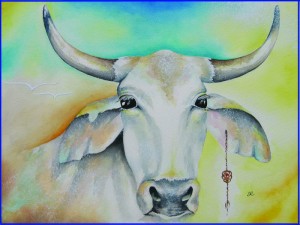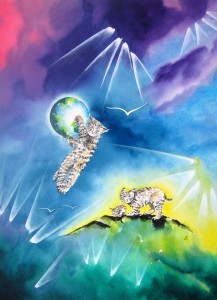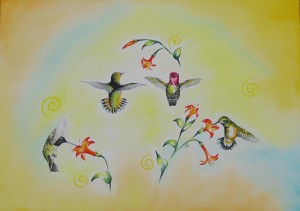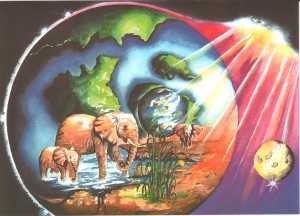The Six Paramitas
By Dr. Will Tuttle
As we deepen our inquiry into the nature of our culture, and how we can best help liberate animals, our Earth, and ourselves from the harmful actions and attitudes causing conflict and destruction, we may begin to realize that the problem is not just other people. We ourselves are part of the problem also. How many people can we actually and substantively change for the better? Quite honestly that number is one.
 This is not to say that we can’t help move our world and other people in a positive direction, but rather to emphasize that this capacity is, paradoxically, a result essentially of our authentic efforts to move ourselves in a positive direction. Most of us, when encountering someone who would like to “improve” us will wisely act to block that effort. Thus, in the end, the most effective way to change others and the world is to endeavor to embody and exemplify in ourselves whatever changes we’d like to see in others.
This is not to say that we can’t help move our world and other people in a positive direction, but rather to emphasize that this capacity is, paradoxically, a result essentially of our authentic efforts to move ourselves in a positive direction. Most of us, when encountering someone who would like to “improve” us will wisely act to block that effort. Thus, in the end, the most effective way to change others and the world is to endeavor to embody and exemplify in ourselves whatever changes we’d like to see in others.
Substantive positive personal change requires inner effort to question the obsolete and harmful attitudes living within us, to understand them, and to heal them through the effort to cultivate a higher and more inclusive and realistic awareness. We have all been wounded from infancy be being born into a herding culture based on the exploitation and abuse of the weak by the strong. In order to build a movement capable of transforming our culture, we are called to undertake the most challenging of all efforts: the effort to transform ourselves.
Grassroots vegan advocacy starts with us as individuals in our communities, endeavoring to become more aware and proficient in our understanding, and in our ability to communicate and cooperate with others. This is the indispensible foundation of the movement to liberate animals, and all of us, from the status quo culture of domination that steals and destroys the sovereignty of both animals and people.
Large non-profit organizations, unlike grassroots efforts, tend to be reductionist and authoritarian in nature. Ironically, herderism, the living core of our cultural mindset and root of our problems, is similarly reductionist and authoritarian, but in the extreme. (If we were born as cows or chickens, we would have no doubt of this.) Thus the large animal protection organizations exist ironically as products of the herding culture and tend to mirror and support its underlying mentality and way of functioning. These organizations compete with one another for funding, and operate under centralized hierarchical structures of authority. The living transformation of vegan awakening tends in their hands to be reduced to a commodity to be marketed by compliant leafletters and spokespeople whose job is to deliver a message that has been crafted by public relations “experts.” Such an approach is ironically an expression of the same mind-set that is creating the problem of animal exploitation in the first place. It tends to muffle the authentic creative voices of individuals who have unique talents and gifts to share.
 Thus, to continually invent and renew a movement for the liberation of animals, we are each called, as individuals, to embody as best we can the change we are working for, and diligently monitor and refresh our organizations to ensure they reflect this same spirit. While going vegan is a liberating, healing, and empowering step for us as individuals, and naturally helps heal and improve our interconnected society, it is not the last step. In many ways, it is the first step of a life where we awaken from being a mere culturally-programmed bio-robot, and step out of the prison of the imposed food narrative of disease and destruction and its many manifestations. Our journey beckons us to continue ever on, so that our inner world, like our outer behavior, ever more fully reflects our core values of respect, kindness, freedom, and harmony.
Thus, to continually invent and renew a movement for the liberation of animals, we are each called, as individuals, to embody as best we can the change we are working for, and diligently monitor and refresh our organizations to ensure they reflect this same spirit. While going vegan is a liberating, healing, and empowering step for us as individuals, and naturally helps heal and improve our interconnected society, it is not the last step. In many ways, it is the first step of a life where we awaken from being a mere culturally-programmed bio-robot, and step out of the prison of the imposed food narrative of disease and destruction and its many manifestations. Our journey beckons us to continue ever on, so that our inner world, like our outer behavior, ever more fully reflects our core values of respect, kindness, freedom, and harmony.
This is the real challenge we all face. It’s much easier and more tempting to blame others (such as political figures, financial elites, and so on) for our problems than it is to work with our internalized attitudes and wounds. And yet, it is only to the degree that we transform ourselves—so that our lives are radiant expressions of the message we would like others to hear—that we will experience our full potential to bring healing and positive change to our world. As the vegan movement becomes increasingly a movement of people who are authentically doing the inner work necessary to explore and purify our individual consciousness, our movement, through this, is becoming increasingly unstoppable.
Satyagraha, the “truth power” that Gandhi described, is ultimately triumphant, and the best way to spread truth is through embodying it so that we plant seeds of change naturally and effectively, with means that reflect the ends we envision. While we don’t try to change others, we can definitely do our best to plant seeds of positive change in others by making these changes congruent in ourselves, so our actions, words, values, thoughts, feelings, and gestures are all aligned within us and people sense this congruency.
How do we make these positive internal changes? With practice. Like with anything else, we become what we practice. The ancient wisdom traditions have many practices that have helped people heal and renew their minds and lives. These practices can be especially helpful for us in contributing to a vegan world of respect and kindness for all.
 One example is the Six Paramitas from the Buddhist tradition, also called the Six Perfections. Paramita in Sanskrit means “crossing over,” so these six Paramitas are qualities that we can cultivate every day to help us cross over to the other shore of greater awareness and freedom. Although the Six Paramitas is an ancient practice, some contemporary teachers have come up with the idea of practicing them by focusing on a different paramita on each day of the week. What follows is the Six Paramitas practice for the seven days of the week, with a short explanation for each one. It’s recommended to recite and contemplate each day’s paramita in the morning to help guide and focus awareness for the day.
One example is the Six Paramitas from the Buddhist tradition, also called the Six Perfections. Paramita in Sanskrit means “crossing over,” so these six Paramitas are qualities that we can cultivate every day to help us cross over to the other shore of greater awareness and freedom. Although the Six Paramitas is an ancient practice, some contemporary teachers have come up with the idea of practicing them by focusing on a different paramita on each day of the week. What follows is the Six Paramitas practice for the seven days of the week, with a short explanation for each one. It’s recommended to recite and contemplate each day’s paramita in the morning to help guide and focus awareness for the day.
Monday, The Day of Giving: Dana Paramita. Let us have all-pervading love, not only for people but for all sentient beings, and give of ourselves and our possessions freely and without regret, with a heart of lovingkindness. Let our giving be rooted in transcendent awareness, knowing the three elements involved are of one essence. Finally, let us remember that the teachings contain no greater wisdom than the wisdom of letting go. This is also called Dana. (Note: the three elements mentioned here are giver, gift, and receiver)
Tuesday, The Day of Ethics: Sila Paramita. Let us maintain standards of discipline, etiquette, and decorum so that our actions are honorable in every situation, and thinking of others always, let us be careful not to harm them in any way. Let us cultivate the natural integrity, diligence, and straightforwardness that fundamental aspects of clear seeing and real virtue.
 Wednesday, The Day of Patience: Kshanti Paramita. Let us treat all beings as the Buddha, seeing through the spell of appearance to the essential reality in which there is no fundamentally separate self. Let us remember that patience is humility, a basic acceptance of this present moment as the perfect unfoldment of life and love, and that it is also an accurate mirror of our present state of mind, and thus continuously bears great opportunities to grow in wisdom and compassion.
Wednesday, The Day of Patience: Kshanti Paramita. Let us treat all beings as the Buddha, seeing through the spell of appearance to the essential reality in which there is no fundamentally separate self. Let us remember that patience is humility, a basic acceptance of this present moment as the perfect unfoldment of life and love, and that it is also an accurate mirror of our present state of mind, and thus continuously bears great opportunities to grow in wisdom and compassion.
Thursday, the Day of Zealous Effort: Virya Paramita. Whatever is appropriate, let us perform it diligently and persistently push forward. Let us be aware of the Source of all energy and activity, and live in harmony with it.
Friday, the Day of Stillness and Stability of Mind: Dhyana Paramita. Let us function in tranquil one-pointedness of mind, free from agitation arising through the senses, and dualistic conceptions of this and that, self and other. Let us let go of tension and separateness, and realize the equanimity that is born of awakening to the truth underlying phenomena.
Saturday, the Day of Wisdom: Prajna Paramita. Let us act so that the mind is always pure and bright, and behave so that we are never uncertain about the rightness of our actions. By the brightness of inherent wisdom, let us dispel the delusion of separateness, and greed and hatred, which spring from ignorance about the real nature of sense objects.
 Sunday, the Day of Service: Simultaneous Practice of all the Paramitas. Let us put all forms of wholesome action into practice, by rendering service to others and practicing generosity, loving speech, beneficial action, and cooperativeness. May lovingkindness and compassion emanate from our every thought, word, and deed, and bless all sentient beings, and may they all realize the original brightness of their minds and be instantly reborn in the Pure Land of clear seeing.
Sunday, the Day of Service: Simultaneous Practice of all the Paramitas. Let us put all forms of wholesome action into practice, by rendering service to others and practicing generosity, loving speech, beneficial action, and cooperativeness. May lovingkindness and compassion emanate from our every thought, word, and deed, and bless all sentient beings, and may they all realize the original brightness of their minds and be instantly reborn in the Pure Land of clear seeing.
In conclusion, with this Six Paramitas practice, the idea is daily to recite and feel into the essential nature of the quality of mind and heart that is being evoked by this day’s Paramita, and to hold it in consciousness throughout the day as best we can. Gradually, and with persistent practice, all six Paramitas will begin to suffuse their healing presence into our awareness in all seven days. We begin to realize that vegan living, nonviolence, respect for animals and other humans, and spiritual liberation are all profoundly interconnected. As we endeavor to embody the universal principles indicated by the six Paramitas, we are working at the roots to help build a more kind and harmonious world for all.
into our awareness in all seven days. We begin to realize that vegan living, nonviolence, respect for animals and other humans, and spiritual liberation are all profoundly interconnected. As we endeavor to embody the universal principles indicated by the six Paramitas, we are working at the roots to help build a more kind and harmonious world for all.
(Paintings by Madeleine W. Tuttle)